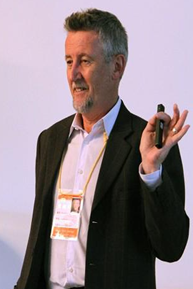 |
Kennedy |
| (澳大利亚布拉格研究所) | |
|
The OPAL nuclear research reactor at ANSTO is a modern 20 MW pool type reactor. OPAL is used for scientific research using neutron beams, radioisotope production (particularly for radiopharmaceuticals) and industrial irradiation services. The neutron beam facility has been designed to compete with the best beam facilities in the world. After seven years in construction, the reactor and neutron beam facilities were commissioned in 2007. OPAL now has ten first rate neutron spectrometers in operation, including one radiography/tomography instrument, with three more under commissioning. The presentation will provide a general introduction to neutron beam methods, and an overview of the world’s leading neutron science facilities with special emphasis on the OPAL neutron beam facility. It will also provide scientific highlights from our research selected to illustrate the potential for applications in scientific research. 作者简介: Kennedy(肯尼迪)博士目前是澳大利亚布拉格研究所(BraggInstitute)的技术主管,也是资深的中子散射技术和应用科学家。在中子散射技术和凝聚态应用研究领域工作已有30余年,肯尼迪博士在澳大利亚OPAL堆的工程建设中作为首席科学家领导了一个超过50人的小组,在一期建设中(1997-2007),该小组完成了从中子源到7台中子散射谱仪的设计、建设和运行工作。自从2007年该堆一期建设完成至今,该中子束线站上已产出了超过400多篇高质量的科研论文并吸引了超过总量30%的国际用户。一期建设结束后,该堆在二期(2009-2014)建设中又完成六台中子散射谱仪,同时三期还在持续规划建设多达4国际先进的各类中子散射谱仪。肯尼迪博士在中子散射技术应用方面有30多年的工作经验,曾在澳大利亚、欧洲和日本的多个顶级学术机构开展研究工作。他的主要科研工作集中在中子谱仪、中子光学、粉末衍射和极化分析的设计、建设和运行方面,并将这些实验技术手段用于磁性材料、超导材料、可再生能源材料和放射医学等方面的研究。肯尼迪博士已发表学术论文140多篇,还有两章的专著内容,h因子达到20,论文平均引用次数达到10次,并先后80多次受邀到世界各地做学术报告,由于在中子散射方面的杰出工作荣获2005年度的AINSE金奖,目前还担任欧洲散裂源中子技术指导组的主席,并是多个中子研究中心学术委员会委员。 澳大利亚布拉格研究所是澳大利亚核科学与技术局下属的中子散射技术与应用研究中心,该研究所基于20MW的OPAL研究堆目前一共拥有14台国际一流的中子散射谱仪,同时澳大利亚的国立氘代实验室也在该研究所。 | |
|
作者简介: 目前是澳大利亚布拉格研究所的技术主管,也是资深的中子散射技术和应用科学家。在中子散射技术和凝聚态应用研究领域工作已有30余年,肯尼迪博士在澳大利亚OPAL堆的工程建设中作为首席科学家领导了一个超过50人的小组。 |

详细内容
【主会场特邀报告】Applications of Neutron Beam Methods in Scientific Research |
| |
共1页 1 |